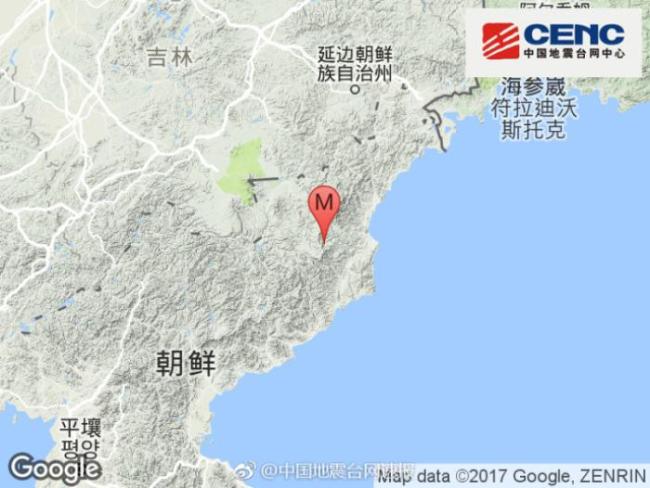NK earthquake not nuclear test: seismology officials
By Yeo Jun-sukPublished : Sept. 24, 2017 - 18:08
A shallow earthquake detected near North Korea’s nuclear test site on Saturday was not the result of a fresh nuclear test by the reclusive regime, South Korea and China’s earthquake-monitoring agencies concluded Sunday.
However, a nuclear test ban watchdog and some seismic experts suspected that the earthquake, whose magnitude ranges from 3.2 to 3.5 depending on regional seismology agencies, could have been a delayed geological reaction to the nuclear test nearly three weeks ago.
The quake was detected in the northern part of Kilju, North Hamgyong Province, just 6 kilometers northwest of where the North conducted its sixth nuclear test on Sept. 3. South Korea’s seismic agency put the magnitude at 3.2, while US and Chinese agencies estimated it to be 3.5 and 3.4, respectively.
Given the nature of seismic waves and the lack of acoustic waves, the incident clearly showed the earthquake was not caused by an artificial explosion, said Woo Nam-chul, an earthquake expert at the meteorological agency.
“We clearly detected the seismic characteristics of P-wave and S-wave, which are shown in natural earthquakes,” Woo was quoted as saying by Yonhap News Agency. “Sound waves are usually detected in the case of artificial earthquakes, but we didn’t capture any sound waves.”
The agency confirmed that it had witnessed two earthquakes in the same area, saying a 2.6 magnitude quake took place 49 kilometers northwest of Kilgu at 1:43 p.m., about four hours before the 3.2 magnitude earthquake hit around the same place.

Reversing its initial assessment of a “suspected explosion,” China Earthquake Networks Center concluded that Saturday’s earthquake was “not a nuclear test,” adding that the incident had the characteristics of a natural earthquake.
The Chinese Academy of Sciences also released a report saying the earthquake was likely a “lagged collapse earthquake,” according to a report by AFP, echoing experts’ assessment that the earthquake was a delayed repercussion of the previous detonation.
In a tweet posted Saturday, Lassina Zerbo, executive secretary of the Comprehensive Nuclear Test Ban Treaty Organization, said the quake was “unlikely man-made” and looked similar to a “collapse” event at North Korea’s Sept. 6 nuclear test.
North Korea’s latest nuclear test -- its sixth to date -- was detected as a 6.3 magnitude earthquake on Sept. 3 and was followed by a 4.1 magnitude quake that experts said could have been a tunnel collapsing after the nuclear explosion.
“The most probable hypothesis at present is that this is a consequence of the previous event, which was of a significant magnitude and may still have repercussions in a fracture zone,” Zerbo said in an interview with AFP.
David Wright of the US-based Union of Concerned Scientists agreed the latest quakes did not appear to have been caused by a new nuclear explosion. “It seems likely that these small tremors are related to the shifts in the ground due to the recent large test,” he told Reuters.
The United States Geological Survey was neutral in its assessment of the cause of the tremor, saying in a statement that it could not “conclusively confirm at this time” whether the earthquake was a natural or human-made event.
With North Korea and the US exchanging bellicose rhetoric over Pyongyang’s relentless pursuit of its nuclear ambition, the world has braced itself for another show of force by the North, which threatened to carry out an atmospheric nuclear test.
In comments to reporters in New York on Thursday, North Korean Foreign Minister Ri Yong-ho said his country’s leader Kim Jong-un is considering whether to demonstrate his ability to detonate a nuclear warhead aboard a missile sent above the Pacific.
By Yeo Jun-suk (jasonyeo@heraldcorp.com)






![[From the Scene] Monks, Buddhists hail return of remains of Buddhas](http://res.heraldm.com/phpwas/restmb_idxmake.php?idx=644&simg=/content/image/2024/04/19/20240419050617_0.jpg&u=20240419175937)







![[From the Scene] Monks, Buddhists hail return of remains of Buddhas](http://res.heraldm.com/phpwas/restmb_idxmake.php?idx=652&simg=/content/image/2024/04/19/20240419050617_0.jpg&u=20240419175937)

![[KH Explains] Hyundai's full hybrid edge to pay off amid slow transition to pure EVs](http://res.heraldm.com/phpwas/restmb_idxmake.php?idx=652&simg=/content/image/2024/04/18/20240418050645_0.jpg&u=20240419100350)

![[Today’s K-pop] Illit drops debut single remix](http://res.heraldm.com/phpwas/restmb_idxmake.php?idx=642&simg=/content/image/2024/04/19/20240419050612_0.jpg&u=)